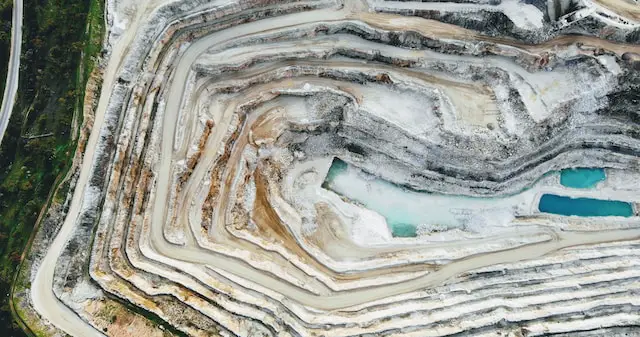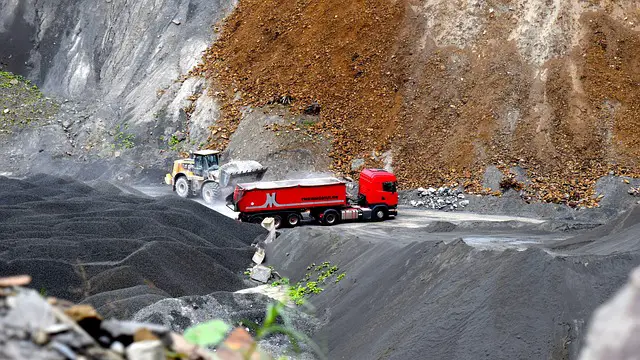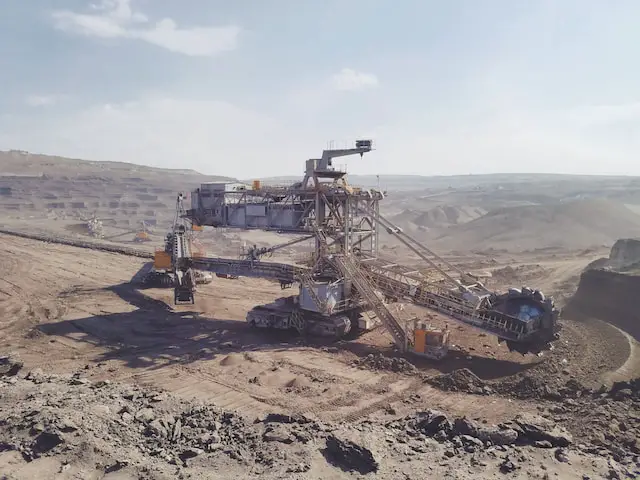Mining typically involves digging deep underground to uncover valuable minerals and other resources, while quarrying typically operates at or near the surface in order to extract stone, sand, gravel and other materials used in construction.
Mining
(Photo by Dion Beetson on Unsplash )

Mining refers to the process of extracting valuable minerals or other geological materials from the earth’s surface or beneath it. It is a broad term that can refer to various methods of extracting minerals or other resources, such as coal, oil, and natural gas.
Mining can be done through open-pit mining, underground mining, or placer mining, depending on the type of mineral or resource being extracted and the geological characteristics of the area. The process typically involves using heavy machinery, such as drills, excavators, and trucks, to extract and transport the material to processing plants or refineries.
Mining can have both positive and negative impacts on the environment and local communities. On the positive side, mining can provide valuable resources and economic opportunities, such as jobs and tax revenues. However, mining can also cause environmental damage, such as soil erosion, water pollution, and deforestation, and can displace indigenous people or disrupt local communities. Therefore, responsible and sustainable mining practices are important to minimize these negative impacts.
Quarrying
(Image by Peter H from Pixabay )

Quarrying is a type of mining that involves extracting stones and minerals from the surface of the earth or from beneath it. It usually involves the use of explosives to break up the rock or soil in which the minerals are located, and heavy machinery to transport the extracted materials to processing plants or refineries.
Quarrying is typically used to extract building materials, such as marble, granite, limestone, and sandstone, which are used for construction and other purposes. It can also be used to extract minerals such as coal, clay, and gypsum.
Like other types of mining, quarrying can have both positive and negative impacts on the environment and local communities. On the positive side, quarrying can provide valuable building materials and economic opportunities, such as jobs and tax revenues. However, quarrying can also cause environmental damage, such as soil erosion, water pollution, and deforestation, and can displace indigenous people or disrupt local communities. Therefore, responsible and sustainable quarrying practices are important to minimize these negative impacts.
Mining Vs. Quarrying – Key differences
While mining and quarrying are both processes of extracting materials from the earth, there are some key differences between the two:
Types of materials: Mining is typically associated with the extraction of minerals such as coal, gold, copper, diamonds, and iron ore, while quarrying is associated with the extraction of construction materials such as limestone, marble, granite, and sandstone.
Depth of extraction: Mining often involves extracting materials from deep within the earth, while quarrying typically involves extracting materials from the surface or just beneath the surface.
Scale of operation: Mining operations are often much larger and more complex than quarrying operations, involving extensive excavation, drilling, and processing of materials on a large scale. Quarrying operations, on the other hand, are often smaller and more localized.
Environmental impact: While both mining and quarrying can have significant environmental impacts, mining is often associated with more severe impacts, including soil erosion, water pollution, deforestation, and the displacement of communities. Quarrying, on the other hand, may have fewer impacts, depending on the specific location and methods used.
Both mining and quarrying involve the extraction of materials from the earth, mining is typically associated with the extraction of minerals from deep within the earth on a large scale, while quarrying is associated with the extraction of construction materials from the surface or just beneath it on a smaller scale.
The benefits and drawbacks of mining and quarrying
Mining and quarrying, while different, share some similar benefits and drawbacks:
Benefits:
- Economic benefits: Both mining and quarrying can provide significant economic benefits to a region or country by creating jobs and generating tax revenues. They can also lead to the development of local infrastructure, such as roads and power supplies, which can benefit the wider community.
- Resource extraction: Both mining and quarrying are means of extracting valuable minerals and metals from the earth, which are used in a wide range of industries, such as construction, electronics, and manufacturing.
- Energy production: Some types of mining, such as coal mining, provide a source of energy that is used to generate electricity and heat homes and businesses.
- Building materials: The materials extracted from quarries are used in the construction industry, including in the production of cement, concrete, and asphalt.
Drawbacks:
- Environmental impacts: Both mining and quarrying can have significant negative impacts on the environment, including soil erosion, water pollution, and habitat destruction. They can also contribute to climate change through the emissions of greenhouse gases.
- Health risks: Workers in mining and quarrying may be exposed to a range of health risks, including respiratory problems, hearing loss, and musculoskeletal disorders.
- Safety hazards: Both mining and quarrying can be dangerous occupations, with the risk of accidents and fatalities from explosions, collapses, falls, and other hazards.
- Social impacts: Both mining and quarrying can lead to social disruption and conflict, particularly in communities that are dependent on agriculture or tourism, which may be adversely affected by mining or quarrying activities.
Mining and quarrying have significant economic benefits and provide valuable resources and building materials, but also have significant environmental and social impacts that need to be addressed to ensure that they are carried out in a responsible and sustainable manner.
What are the different types of quarrying?
There are several different types of quarrying, each of which is used to extract different types of materials. Here are some of the most common types:
Open-pit quarrying: This involves the extraction of rock or minerals from an open pit or surface excavation. It is typically used to extract building materials such as stone, sand, and gravel.
Underground quarrying: This involves the extraction of rock or minerals from underground tunnels or shafts. It is typically used to extract minerals such as coal, copper, and gold.
Dimension stone quarrying: This involves the extraction of blocks or slabs of stone that can be cut and shaped into specific sizes and shapes for use in construction projects such as buildings and monuments.
Surface quarrying: This involves the removal of layers of soil and rock to access the materials beneath. It is typically used to extract materials such as clay, coal, and limestone.
Rock blasting: This involves the use of explosives to break up rock formations for easier extraction. It is typically used in open-pit quarrying and underground mining.
Drilling and coring: This involves the use of specialized drilling equipment to extract samples of rock or mineral deposits for testing and analysis.
What are the different types of mining?
There are several different types of mining, each of which is used to extract different types of resources. Here are some of the most common types:
Surface mining: This involves the removal of surface-level soil, rock, and vegetation to access mineral deposits beneath. It is typically used to extract minerals such as coal, iron ore, and gold.
Underground mining: This involves the extraction of minerals from underground tunnels or shafts. It is typically used to extract minerals such as copper, lead, and zinc.
Placer mining: This involves the extraction of minerals from alluvial deposits (i.e. deposits of sand, gravel, and soil) that are found in or near rivers and streams. It is typically used to extract minerals such as gold, tin, and diamonds.
Mountaintop removal mining: This involves the removal of entire mountaintops to access coal deposits beneath. It is a controversial form of surface mining due to its significant environmental impact.
Subsurface mining: This involves the extraction of minerals from deep underground, often using tunnels and shafts. It is typically used to extract minerals such as coal and uranium.
Solution mining: This involves the use of chemicals to dissolve mineral deposits, which are then pumped to the surface. It is typically used to extract minerals such as salt, potash, and sulfur.
Featured Image By – Albert Hyseni on Unsplash








